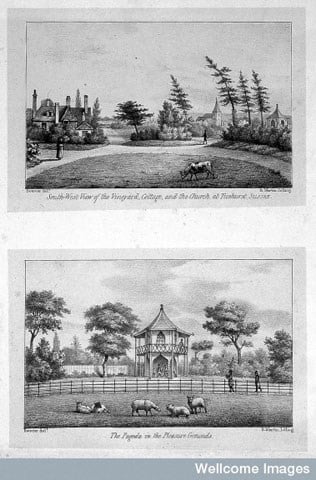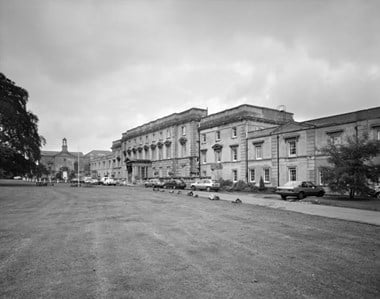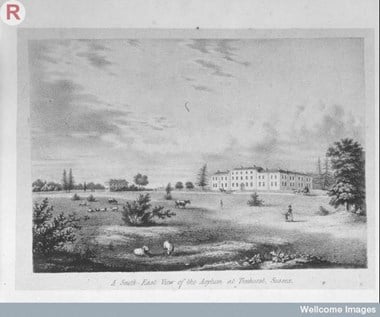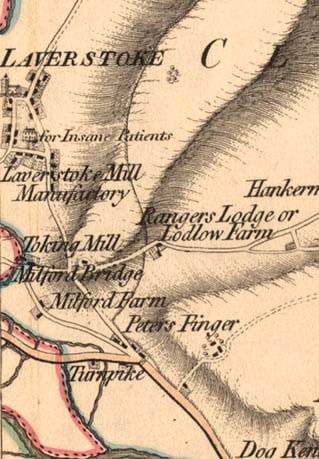The Age of the Madhouse - Home of the Well-Attired Ploughman
This section describes the changes in attitude to madness that led to the growth of private madhouses for the better-off, though paupers were sometimes admitted. In these institutions treatment was often subject to the whims of the proprietors, known as the 'mad doctors'.
In this section
Audio version: 🔊 Listen to this page and others in 'Disability from 1660-1832' as an MP3
New attitudes to madness
A unique feature of English society in the 18th century was the private madhouse.
Madness was increasingly seen as the loss of a person's reason, rather than a defect of their soul or their body. It could be restored through 'moral treatment': gentle discipline, order and well intentioned manipulation. And where better to do this than in an orderly, well managed, small private madhouse, with its family atmosphere and controlled environment?
Private madhouses
By the end of the century there were about 45 of these officially licensed private dwellings around the country. They were occasionally purpose-built but mainly adapted to accommodate 'the mad'. They catered largely for better-off residents, particularly the smaller houses, which charged the highest fees and accommodated only five or six people.
There were a few larger houses which housed some 'pauper lunatics' paid for by the parish. Here, living areas for paupers and private patients were strictly segregated and widely differed in quality.
Servants, silk breeches and indoor games
From the 1790s at the very select Ticehurst House in Ticehurst, Sussex, patients could bring their own servants, some lodging in their own dwelling in the grounds of the large house. A pack of beagles was kept so that gentleman patients could enjoy the hunt.
Work was felt to be very important for the restoration of reason. At the madhouse in Shillingthorpe, Lincolnshire run by Dr Francis Willis (1718-1807), who was famous for treating George III (1738-1820), 'the unprepared traveller … was astonished to find almost all the surrounding ploughmen, gardeners, threshers, thatchers and other labourers attired in black coats, black silk breeches and stockings, and the head of each bien poudrée, frisée et araignée' (well powdered, curled and styled) These were the doctor's patients.
Many homes advertised their extensive gardens or pleasure grounds that were often walled to prevent patients wandering. The better houses might have a bowling green, a small library and indoor games like bagatelle.
'Arbitrary and Cruel Acts'
Behind the high ideals and optimism, standards varied widely and there was growing disquiet about treatment in these private institutions. In 1763 The Gentleman's Magazine condemned the 'many unlawful arbitrary and cruel acts' which went on in madhouses.
At Lainston House near Winchester, Hampshire, private patients resided in the mansion but paupers were kept in converted stables and outbuildings. The home was closed in 1847 for mistreatment of its paupers who had been left chained in cold and filthy conditions. In 1846 there was a public enquiry into ill treatment and corruption at Haydock Lodge, Winwick in Lancashire. By 1851 it had been shut down.
The 'mad doctors' in charge
The proprietors, known as 'mad doctors', were a varied group and not necessarily medically qualified. They had little social or professional status and included clergymen, quack doctors and family dynasties.
Medical qualification did not guarantee quality of care. That depended more on the charitable instincts and motives of the proprietor, like those who ran more reputable institutions such as Brislington House, near Bristol in Somerset and Laverstoke House near Salisbury, Wiltshire.
The licensing of madhouses
From 1774 the Regulation of Madhouses Act introduced a licensing system, following public concern that some non-lunatics were being unlawfully detained at the whim of their spouses or families.
With the growth of state-managed county asylums in the 19th century the private madhouse declined, although several survived in some form through to the 20th century.
Watch the BSL video on the age of the madhouse
The Age of the Madhouse
Please click on the gallery images to enlarge.










